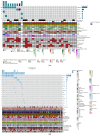Immune Checkpoint Inhibitor Therapy and Associations with Clonal Hematopoiesis
- PMID: 39456832
- PMCID: PMC11508050
- DOI: 10.3390/ijms252011049
Immune Checkpoint Inhibitor Therapy and Associations with Clonal Hematopoiesis
Abstract
Cancer cohorts are now known to be associated with increased rates of clonal hematopoiesis (CH). We sort to characterize the hematopoietic compartment of patients with melanoma and non-small cell lung cancer (NSCLC) given our recent population level analysis reporting evolving rates of secondary leukemias. The advent of immune checkpoint blockade (ICB) has dramatically changed our understanding of cancer biology and has altered the standards of care for patients. However, the impact of ICB on hematopoietic myeloid clonal expansion remains to be determined. We studied if exposure to ICB therapy affects hematopoietic clonal architecture and if their evolution contributed to altered hematopoiesis. Blood samples from patients with melanoma and NSCLC (n = 142) demonstrated a high prevalence of CH. Serial samples (or post ICB exposure samples; n = 25) were evaluated in melanoma and NSCLC patients. Error-corrected sequencing of a targeted panel of genes recurrently mutated in CH was performed on peripheral blood genomic DNA. In serial sample analysis, we observed that mutations in DNMT3A and TET2 increased in size with longer ICB exposures in the melanoma cohort. We also noted that patients with larger size DNMT3A mutations with further post ICB clone size expansion had longer durations of ICB exposure. All serial samples in this cohort showed a statistically significant change in VAF from baseline. In the serial sample analysis of NSCLC patients, we observed similar epigenetic expansion, although not statistically significant. Our study generates a hypothesis for two important questions: (a) Can DNMT3A or TET2 CH serve as predictors of a response to ICB therapy and serve as a novel biomarker of response to ICB therapy? (b) As ICB-exposed patients continue to live longer, the myeloid clonal expansion may portend an increased risk for subsequent myeloid malignancy development. Until now, the selective pressure of ICB/T-cell activating therapies on hematopoietic stem cells were less known and we report preliminary evidence of clonal expansion in epigenetic modifier genes (also referred to as inflammatory CH genes).
Keywords: DNMT3A; TET2; clonal hematopoiesis of indeterminate potential; immune checkpoint blockade; immune checkpoint inhibitor; melanoma; non-small cell lung cancer.
Conflict of interest statement
Dr. Duane C. Hassane was employed at Tempus Labs, Inc. The authors declare that this research was conducted in the absence of any commercial or financial relationships that could be construed as a potential conflict of interest. The funders had no role in the design of the study; in the collection, analyses, or interpretation of data; in the writing of the manuscript, or in the decision to publish the results.
Figures



References
-
- Singh A., Mencia-Trinchant N., Griffiths E.A., Altahan A., Swaminathan M., Gupta M., Gravina M., Tajammal R., Faber M.G., Yan L., et al. Mutant PPM1D- and TP53-Driven Hematopoiesis Populates the Hematopoietic Compartment in Response to Peptide Receptor Radionuclide Therapy. JCO Precis. Oncol. 2022;6:e2100309. doi: 10.1200/PO.21.00309. - DOI - PMC - PubMed
-
- Gibson C.J., Lindsley R.C., Tchekmedyian V., Mar B.G., Shi J., Jaiswal S., Bosworth A., Francisco L., He J., Bansal A., et al. Clonal Hematopoiesis Associated With Adverse Outcomes After Autologous Stem-Cell Transplantation for Lymphoma. J. Clin. Oncol. 2017;35:1598–1605. doi: 10.1200/JCO.2016.71.6712. - DOI - PMC - PubMed
-
- Mouhieddine T.H., Sperling A.S., Redd R., Park J., Leventhal M., Gibson C.J., Manier S., Nassar A.H., Capelletti M., Huynh D., et al. Clonal hematopoiesis is associated with adverse outcomes in multiple myeloma patients undergoing transplant. Nat. Commun. 2020;11:2996. doi: 10.1038/s41467-020-16805-5. - DOI - PMC - PubMed
-
- Wong T.N., Miller C.A., Jotte M.R.M., Bagegni N., Baty J.D., Schmidt A.P., Cashen A.F., Duncavage E.J., Helton N.M., Fiala M., et al. Cellular stressors contribute to the expansion of hematopoietic clones of varying leukemic potential. Nat. Commun. 2018;9:455. doi: 10.1038/s41467-018-02858-0. - DOI - PMC - PubMed
MeSH terms
Substances
LinkOut - more resources
Full Text Sources
Medical
Research Materials

